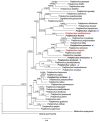The Genus Pratylenchus (Nematoda: Pratylenchidae) in Israel: From Taxonomy to Control Practices
- PMID: 33147883
- PMCID: PMC7716202
- DOI: 10.3390/plants9111475
The Genus Pratylenchus (Nematoda: Pratylenchidae) in Israel: From Taxonomy to Control Practices
Abstract
Due to Israel's successful agricultural production and diverse climatic conditions, plant-parasitic nematodes are flourishing. The occurrence of new, previously unidentified species in Israel or of suggested new species worldwide is a consequence of the continuous withdrawal of efficient nematicides. Among plant-parasitic nematodes, migratory endoparasitic species of the genus Pratylenchus are widely distributed in vegetable and crop fields in Israel and are associated with major reductions in quality and yield. This review focuses on the occurrence, distribution, diagnosis, pathogenicity, and phylogeny of all Pratylenchus species recorded over the last few decades on different crops grown throughout Israel-covering early information from nematologists to recent reports involving the use of molecular phylogenetic methodologies. We explore the accepted distinction between Pratylenchus thornei and Pratylenchus mediterraneus isolated from Israel's northern Negev region, and address the confusion concerning the findings related to these Pratylenchus species. Our recent sampling from the northern Negev revealed the occurrence of both P. thornei and P. mediterraneus on the basis of molecular identification, indicating P. mediterraneus as a sister species of P. thornei and their potential occurrence in a mixed infection. Finally, the efficiencies of common control measures taken to reduce Pratylenchus' devastating damage in protected crops and field crops is discussed.
Keywords: Pratylenchus; control management practices; distribution; molecular phylogeny; pathogenicity; root lesion nematode; taxonomy.
Conflict of interest statement
The authors declare no conflict of interest.
Figures





Similar articles
-
Pratylenchus vovlasi sp. Nov. (Nematoda: Pratylenchidae) on Raspberries in North Italy with a Morphometrical and Molecular Characterization.Plants (Basel). 2021 May 26;10(6):1068. doi: 10.3390/plants10061068. Plants (Basel). 2021. PMID: 34073469 Free PMC article.
-
Distribution, morphological and molecular characterization of root-lesion nematodes (Pratylenchus spp.) (Tylenchida: Pratylenchidae) in maize (Zea mays L.) (Poales: Poaceae) in Türkiye.Mol Biol Rep. 2024 Aug 19;51(1):918. doi: 10.1007/s11033-024-09843-5. Mol Biol Rep. 2024. PMID: 39158609
-
Gene silencing in root lesion nematodes (Pratylenchus spp.) significantly reduces reproduction in a plant host.Exp Parasitol. 2013 Feb;133(2):166-78. doi: 10.1016/j.exppara.2012.11.011. Epub 2012 Nov 29. Exp Parasitol. 2013. PMID: 23201220
-
Root-Lesion Nematodes Affecting Dryland Cereals in the Semiarid Pacific Northwest U.S.A.Plant Dis. 2021 Nov;105(11):3324-3343. doi: 10.1094/PDIS-04-21-0883-FE. Epub 2021 Nov 24. Plant Dis. 2021. PMID: 34236212 Review.
-
A Systematic Review of the Effects of Arbuscular Mycorrhizal Fungi on Root-Lesion Nematodes, Pratylenchus spp.Front Plant Sci. 2020 Jul 14;11:923. doi: 10.3389/fpls.2020.00923. eCollection 2020. Front Plant Sci. 2020. PMID: 32765542 Free PMC article.
Cited by
-
Plant-Parasitic Nematodes Associated with Strawberry and Molecular Identification of Meloidogyne and Pratylenchus Species in the Central Region of Costa Rica.J Nematol. 2025 Aug 31;57(1):20250033. doi: 10.2478/jofnem-2025-0033. eCollection 2025 Feb. J Nematol. 2025. PMID: 40895232 Free PMC article.
-
Pratylenchus Araucensis (Rhabditida: Pratylenchidae) a Widely Distributed Nematode in Musa Spp. from Colombia.J Nematol. 2023 Jan 8;54(1):20220057. doi: 10.2478/jofnem-2022-0057. eCollection 2022 Feb. J Nematol. 2023. PMID: 36742266 Free PMC article.
-
Occurrence and Geographic Distribution of Plant-Parasitic Nematodes Associated with Citrus in Morocco and Their Interaction with Soil Patterns.Life (Basel). 2022 Apr 25;12(5):637. doi: 10.3390/life12050637. Life (Basel). 2022. PMID: 35629306 Free PMC article.
References
-
- Geraert E. The Pratylenchidae of the World: Identification of the Family Pratylenchidae (Nematoda: Tylenchida) Academia Press; Ghent, Belgium: 2013.
-
- Palomares-Rius J.E., Guesmi I., Horrigue-Raouani N., Cantalapiedra-Navarrete C., Liébanas G., Castillo P. Morphological and molecular characterisation of Pratylenchus oleae n. sp.(Nematoda: Pratylenchidae) parasitizing wild and cultivated olives in Spain and Tunisia. Eur. J. Plant Pathol. 2014;140:53–67. doi: 10.1007/s10658-014-0443-4. - DOI
-
- Nicol J., Turner S., Coyne D., Den Nijs L., Hockland S., Maafi Z.T. Genomics and Molecular Genetics of Plant-Nematode Interactions. Springer; Dordrecht, The Netherlands: 2011. Current nematode threats to world agriculture; pp. 21–43.
-
- Jones M., Fosu-Nyarko J. Molecular biology of root lesion nematodes (Pratylenchus spp.) and their interaction with host plants. Ann. Appl. Biol. 2014;164:163–181. doi: 10.1111/aab.12105. - DOI
Publication types
Grants and funding
LinkOut - more resources
Full Text Sources

